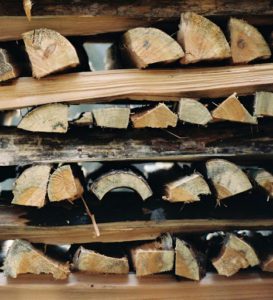If you’ve ever tried to stack green firewood yourself, you know that it can be very frustrating. Piles collapse, orderly rows bend or fall over, and hours of work are erased. This is the experience of almost every wood stacking novice. The good news is that it gets a lot easier with practice! After a few days spent stacking, most people figure out a system that works and makes sense to them.
That said, if you’re new to wood stacking, that’s not of much consolation. That’s why we’ve put together these tips to help you to go from novice to veteran wood stacker in the least time possible! But first, it’s important to understand why stacking wood properly is so important.
Why Is Stacking Firewood Well So Important?
When green wood is stacked properly, it becomes naturally seasoned over time. In a proper wood pile, the heat of the sun and the circulation of dry air removes the moisture from the wood so that it burns easier, hotter, and cleaner. When there’s too much moisture in wood it burns at a lower temperature, or fitfully, and produces more smoke and creosote, which can make it very dangerous to burn in your home. Creosote coats chimneys and is flammable, leading to chimney fires when it builds up and isn’t cleaned out.
Additionally, improperly stacking firewood can lead to mice infestations, fungus and mold growth, termites and snakes taking up residence, and is a bit of an eye sore. Improving your knowledge of proper stacking protocols and techniques will help to reduce these negative effects and maximize the rate at which your wood dries out, keeping you warm in the winter. Heating with a wood fire is never completely safe, but it can be made safer if it’s properly dried and stored.

Tips
- Split Your Logs Before Stacking Them
Maybe this one is obvious to you, but if you split your logs they’re both easier to stack and will dry much faster. Try to have relatively evenly split logs to maximize the ease of stacking and therefore maximizing the drying you can achieve.
- Size Logs Appropriately
This isn’t so much about stacking firewood as it is about making sure you’re not laboring in vain. You have to make sure the wood you’re stacking is actually the right size for your wood stove. Having little range in your logs is fine, as long as they fit in your wood stove and aren’t so irregular that they make stacking difficult. The more regular and uniform your logs are, the easier they are to work with.
- Choose the Right Place To Stack
There are several things you should keep in mind when planning your wood stacking venture. One of the most overlooked is location. You need to keep your woodpile a little elevated compared to the surrounding land. This keeps it drier, and gives it more access to wind. If you have strong, regularly prevailing winds in your area, orient your stack to take advantage of the wind by facing the cut ends of the logs towards the wind. This will lead to wind blowing across the logs optimally, maximizing drying.
You should also avoid placing your wood pile against your house, as this makes it much more likely that any pests that arise in your wood pile will spread to your home and blocks the wind you need to dry the pile out.
If you have a couple of trees that are 10 to 16 feet apart with flat, dry, open land between them on your land, this is ideal for stacking. You can use the trees as bookends for your pile, allowing you to stack higher with greater stability.
- Stack Loosely but Firmly
It’s important to strike a good balance between looseness that allows air to flow and tightness that provides stability. There’s an old Scandinavian adage that suggests a mouse should be able to scurry between your logs, but a cat should be unable to follow. Further, for the sake of safety, it’s important that your wood pile can support significant weight without collapsing. Stabilizing ends, like trees or end pillars (see below), helps to provide the stability you need without choking off the wood so it cannot dry out efficiently.
- Stabilize With End Pillars
There are many ways to add stability to your wood pile. One of the most flexible is building what’s often called an end pillar. This is when you stack logs with alternating orientation, similar to Lincoln logs. Placing these at either end of your stack so that the logs in the middle stay in place is a traditional way to stack firewood for drying, and it’s very effective.
- Have Fun!
While stacking firewood is certainly important, it can be a lot of fun. Engaging with the right mindset (one of enjoying the exertion, the smell of the earthy wood and fresh air makes for a far more pleasant time. If you’re having fun while engaging with the task, you’re less likely to get sidetracked or to think about other things and make mistakes.
Need to Buy Firewood?
At Day Logging, we make sure all our firewood is cut uniformly to make stacking easier and get you the consistent fuel quality you need to plan for New England winters. To place an order for green, seasoned, or kiln-dried firewood with Day Logging, please contact us today.
